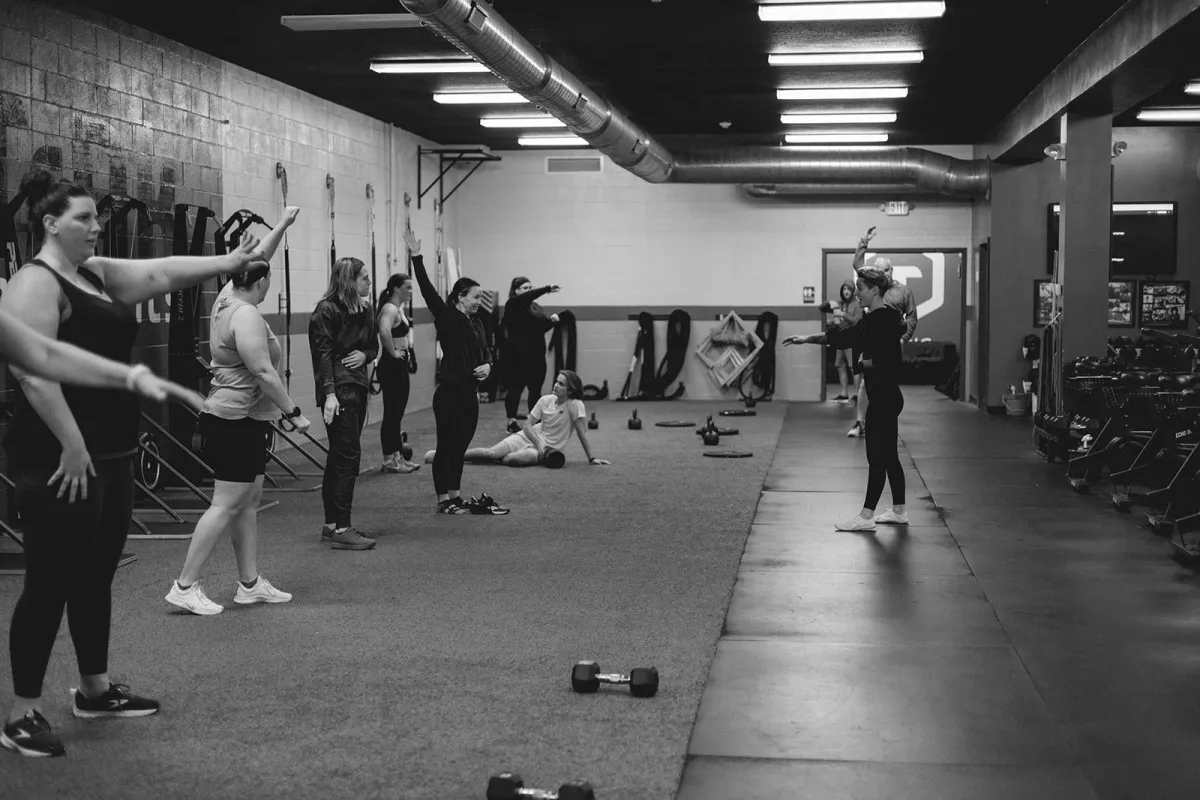Fitness Blogs

Unlocking the Secrets of "Increasing" Your Metabolism: Why Strength and Activity Matter at Every Age
Unlocking the Secrets of "Increasing" Your Metabolism: Why Strength and Activity Matter at Every Age
Hey TrAk Fam! Coach Sean here, and today we’re tackling a topic that trips up many as they move out of their 20s and into the next chapter of life: your metabolism. If you’ve ever thought, “I can’t lose weight like I used to,” or “My metabolism must be broken,” you’re not alone. Let’s bust some myths, understand what’s happening with your body, and, most importantly, dive into what you can do about it. Spoiler alert: You’re not broken, and neither is your metabolism! Here’s what you need to do: 1) Strength train consistently, 2) Increase your daily movement, and 3) Support your efforts with proper nutrition and recovery and we are going to break it down for you below.

The Myth of the Slowing Metabolism
First, let’s get this straight: Your metabolism isn’t grinding to a halt as you age. Research published in the Journal of Science in 2021 found that resting metabolic rates remain relatively stable from your 20s through your 60s. The slight dip doesn’t begin until your 60s, and even then, it’s not the dramatic culprit behind weight gain that many believe. So, if your metabolism isn’t the villain, what is?
Meet Your Real Metabolic Game Changers: NEAT and Muscle Mass
1. NEAT: Non-Exercise Activity Thermogenesis
NEAT encompasses all the calories you burn through non-exercise activities like walking the dog, cleaning the house, or even fidgeting. As we age, our NEAT levels tend to drop. Think about it: In your younger years, you may have played sports, walked to class, or spent more time on your feet. Now, you might find yourself sitting at a desk, commuting, or opting for convenience over movement.
According to a Mayo Clinic study, NEAT can account for up to 50% of your daily calorie burn. If your NEAT drops—say, from 500 calories to 100 calories—that’s a 400-calorie deficit you’re no longer burning. This shift can easily lead to gradual weight gain. The good news? You can fix it by reintroducing more movement into your daily routine. Small changes, like taking the stairs, setting a timer to get up every hour, or adding short walks, can make a big difference.
2. Muscle Mass: Your Metabolic Ally
Muscle is one of the most metabolically active tissues in your body. Unlike fat, which just sits there, muscle burns calories even at rest. But here’s the catch: Starting in your 30s, you can lose 3-8% of your muscle mass per decade if you’re not actively strength training. This muscle loss impacts more than your metabolism—it affects your insulin sensitivity, energy levels, and overall health.
Shockingly, only 4% of adults strength train regularly (meaning 2-3 days a week). Strength training not only helps you maintain or build muscle, but studies from Harvard show it can also boost your resting metabolism by up to 15%. And when you’re stronger, you’re better equipped to handle life’s demands, from keeping up with kids to tackling late-night cravings.
The Path to a Stronger, More Active You
The beauty of your body is its adaptability. No matter your age, you can build muscle, increase your NEAT, and revitalize your metabolism. Here’s how to get started:
1. Strength Training is Non-Negotiable
Aim for at least three days a week, focusing on compound movements that target multiple muscle groups. Exercises like squats, deadlifts, and presses are your ticket to building muscle and boosting your metabolism.
2. Move More Throughout the Day
Incorporate more movement into your routine:
Take the stairs instead of the elevator.
Park farther from your destination.
Schedule short, 5-minute walks every hour.
Aim for 10,000 steps a day or more.
3. Prioritize Protein and Recovery
Nutrition and sleep play critical roles in your metabolic health. Prioritize protein in your meals to support muscle growth and repair. Get 7-8 hours of quality sleep to help regulate hormones, reduce cravings, and support recovery.
4. Consistency Over Perfection
Building strength and increasing activity are long-term investments. Every workout, every walk, every healthy choice is a step closer to a healthier you. Progress might feel slow, but it’s happening—and it’s worth it.
Final Thoughts
Your metabolism isn’t broken, and neither are you. By focusing on strength training, increasing your daily activity, and supporting your body with proper nutrition and recovery, you can achieve the body and lifestyle you want—no matter your age. Remember, every small step adds up. So, let’s build strength, boost energy, and keep moving forward. See you in the gym!
Recovery Blogs

Unlocking the Secrets of "Increasing" Your Metabolism: Why Strength and Activity Matter at Every Age
Unlocking the Secrets of "Increasing" Your Metabolism: Why Strength and Activity Matter at Every Age
Hey TrAk Fam! Coach Sean here, and today we’re tackling a topic that trips up many as they move out of their 20s and into the next chapter of life: your metabolism. If you’ve ever thought, “I can’t lose weight like I used to,” or “My metabolism must be broken,” you’re not alone. Let’s bust some myths, understand what’s happening with your body, and, most importantly, dive into what you can do about it. Spoiler alert: You’re not broken, and neither is your metabolism! Here’s what you need to do: 1) Strength train consistently, 2) Increase your daily movement, and 3) Support your efforts with proper nutrition and recovery and we are going to break it down for you below.

The Myth of the Slowing Metabolism
First, let’s get this straight: Your metabolism isn’t grinding to a halt as you age. Research published in the Journal of Science in 2021 found that resting metabolic rates remain relatively stable from your 20s through your 60s. The slight dip doesn’t begin until your 60s, and even then, it’s not the dramatic culprit behind weight gain that many believe. So, if your metabolism isn’t the villain, what is?
Meet Your Real Metabolic Game Changers: NEAT and Muscle Mass
1. NEAT: Non-Exercise Activity Thermogenesis
NEAT encompasses all the calories you burn through non-exercise activities like walking the dog, cleaning the house, or even fidgeting. As we age, our NEAT levels tend to drop. Think about it: In your younger years, you may have played sports, walked to class, or spent more time on your feet. Now, you might find yourself sitting at a desk, commuting, or opting for convenience over movement.
According to a Mayo Clinic study, NEAT can account for up to 50% of your daily calorie burn. If your NEAT drops—say, from 500 calories to 100 calories—that’s a 400-calorie deficit you’re no longer burning. This shift can easily lead to gradual weight gain. The good news? You can fix it by reintroducing more movement into your daily routine. Small changes, like taking the stairs, setting a timer to get up every hour, or adding short walks, can make a big difference.
2. Muscle Mass: Your Metabolic Ally
Muscle is one of the most metabolically active tissues in your body. Unlike fat, which just sits there, muscle burns calories even at rest. But here’s the catch: Starting in your 30s, you can lose 3-8% of your muscle mass per decade if you’re not actively strength training. This muscle loss impacts more than your metabolism—it affects your insulin sensitivity, energy levels, and overall health.
Shockingly, only 4% of adults strength train regularly (meaning 2-3 days a week). Strength training not only helps you maintain or build muscle, but studies from Harvard show it can also boost your resting metabolism by up to 15%. And when you’re stronger, you’re better equipped to handle life’s demands, from keeping up with kids to tackling late-night cravings.
The Path to a Stronger, More Active You
The beauty of your body is its adaptability. No matter your age, you can build muscle, increase your NEAT, and revitalize your metabolism. Here’s how to get started:
1. Strength Training is Non-Negotiable
Aim for at least three days a week, focusing on compound movements that target multiple muscle groups. Exercises like squats, deadlifts, and presses are your ticket to building muscle and boosting your metabolism.
2. Move More Throughout the Day
Incorporate more movement into your routine:
Take the stairs instead of the elevator.
Park farther from your destination.
Schedule short, 5-minute walks every hour.
Aim for 10,000 steps a day or more.
3. Prioritize Protein and Recovery
Nutrition and sleep play critical roles in your metabolic health. Prioritize protein in your meals to support muscle growth and repair. Get 7-8 hours of quality sleep to help regulate hormones, reduce cravings, and support recovery.
4. Consistency Over Perfection
Building strength and increasing activity are long-term investments. Every workout, every walk, every healthy choice is a step closer to a healthier you. Progress might feel slow, but it’s happening—and it’s worth it.
Final Thoughts
Your metabolism isn’t broken, and neither are you. By focusing on strength training, increasing your daily activity, and supporting your body with proper nutrition and recovery, you can achieve the body and lifestyle you want—no matter your age. Remember, every small step adds up. So, let’s build strength, boost energy, and keep moving forward. See you in the gym!
Mindset Blogs

Unlocking the Secrets of "Increasing" Your Metabolism: Why Strength and Activity Matter at Every Age
Unlocking the Secrets of "Increasing" Your Metabolism: Why Strength and Activity Matter at Every Age
Hey TrAk Fam! Coach Sean here, and today we’re tackling a topic that trips up many as they move out of their 20s and into the next chapter of life: your metabolism. If you’ve ever thought, “I can’t lose weight like I used to,” or “My metabolism must be broken,” you’re not alone. Let’s bust some myths, understand what’s happening with your body, and, most importantly, dive into what you can do about it. Spoiler alert: You’re not broken, and neither is your metabolism! Here’s what you need to do: 1) Strength train consistently, 2) Increase your daily movement, and 3) Support your efforts with proper nutrition and recovery and we are going to break it down for you below.

The Myth of the Slowing Metabolism
First, let’s get this straight: Your metabolism isn’t grinding to a halt as you age. Research published in the Journal of Science in 2021 found that resting metabolic rates remain relatively stable from your 20s through your 60s. The slight dip doesn’t begin until your 60s, and even then, it’s not the dramatic culprit behind weight gain that many believe. So, if your metabolism isn’t the villain, what is?
Meet Your Real Metabolic Game Changers: NEAT and Muscle Mass
1. NEAT: Non-Exercise Activity Thermogenesis
NEAT encompasses all the calories you burn through non-exercise activities like walking the dog, cleaning the house, or even fidgeting. As we age, our NEAT levels tend to drop. Think about it: In your younger years, you may have played sports, walked to class, or spent more time on your feet. Now, you might find yourself sitting at a desk, commuting, or opting for convenience over movement.
According to a Mayo Clinic study, NEAT can account for up to 50% of your daily calorie burn. If your NEAT drops—say, from 500 calories to 100 calories—that’s a 400-calorie deficit you’re no longer burning. This shift can easily lead to gradual weight gain. The good news? You can fix it by reintroducing more movement into your daily routine. Small changes, like taking the stairs, setting a timer to get up every hour, or adding short walks, can make a big difference.
2. Muscle Mass: Your Metabolic Ally
Muscle is one of the most metabolically active tissues in your body. Unlike fat, which just sits there, muscle burns calories even at rest. But here’s the catch: Starting in your 30s, you can lose 3-8% of your muscle mass per decade if you’re not actively strength training. This muscle loss impacts more than your metabolism—it affects your insulin sensitivity, energy levels, and overall health.
Shockingly, only 4% of adults strength train regularly (meaning 2-3 days a week). Strength training not only helps you maintain or build muscle, but studies from Harvard show it can also boost your resting metabolism by up to 15%. And when you’re stronger, you’re better equipped to handle life’s demands, from keeping up with kids to tackling late-night cravings.
The Path to a Stronger, More Active You
The beauty of your body is its adaptability. No matter your age, you can build muscle, increase your NEAT, and revitalize your metabolism. Here’s how to get started:
1. Strength Training is Non-Negotiable
Aim for at least three days a week, focusing on compound movements that target multiple muscle groups. Exercises like squats, deadlifts, and presses are your ticket to building muscle and boosting your metabolism.
2. Move More Throughout the Day
Incorporate more movement into your routine:
Take the stairs instead of the elevator.
Park farther from your destination.
Schedule short, 5-minute walks every hour.
Aim for 10,000 steps a day or more.
3. Prioritize Protein and Recovery
Nutrition and sleep play critical roles in your metabolic health. Prioritize protein in your meals to support muscle growth and repair. Get 7-8 hours of quality sleep to help regulate hormones, reduce cravings, and support recovery.
4. Consistency Over Perfection
Building strength and increasing activity are long-term investments. Every workout, every walk, every healthy choice is a step closer to a healthier you. Progress might feel slow, but it’s happening—and it’s worth it.
Final Thoughts
Your metabolism isn’t broken, and neither are you. By focusing on strength training, increasing your daily activity, and supporting your body with proper nutrition and recovery, you can achieve the body and lifestyle you want—no matter your age. Remember, every small step adds up. So, let’s build strength, boost energy, and keep moving forward. See you in the gym!
AOM Blogs

Unlocking the Secrets of "Increasing" Your Metabolism: Why Strength and Activity Matter at Every Age
Unlocking the Secrets of "Increasing" Your Metabolism: Why Strength and Activity Matter at Every Age
Hey TrAk Fam! Coach Sean here, and today we’re tackling a topic that trips up many as they move out of their 20s and into the next chapter of life: your metabolism. If you’ve ever thought, “I can’t lose weight like I used to,” or “My metabolism must be broken,” you’re not alone. Let’s bust some myths, understand what’s happening with your body, and, most importantly, dive into what you can do about it. Spoiler alert: You’re not broken, and neither is your metabolism! Here’s what you need to do: 1) Strength train consistently, 2) Increase your daily movement, and 3) Support your efforts with proper nutrition and recovery and we are going to break it down for you below.

The Myth of the Slowing Metabolism
First, let’s get this straight: Your metabolism isn’t grinding to a halt as you age. Research published in the Journal of Science in 2021 found that resting metabolic rates remain relatively stable from your 20s through your 60s. The slight dip doesn’t begin until your 60s, and even then, it’s not the dramatic culprit behind weight gain that many believe. So, if your metabolism isn’t the villain, what is?
Meet Your Real Metabolic Game Changers: NEAT and Muscle Mass
1. NEAT: Non-Exercise Activity Thermogenesis
NEAT encompasses all the calories you burn through non-exercise activities like walking the dog, cleaning the house, or even fidgeting. As we age, our NEAT levels tend to drop. Think about it: In your younger years, you may have played sports, walked to class, or spent more time on your feet. Now, you might find yourself sitting at a desk, commuting, or opting for convenience over movement.
According to a Mayo Clinic study, NEAT can account for up to 50% of your daily calorie burn. If your NEAT drops—say, from 500 calories to 100 calories—that’s a 400-calorie deficit you’re no longer burning. This shift can easily lead to gradual weight gain. The good news? You can fix it by reintroducing more movement into your daily routine. Small changes, like taking the stairs, setting a timer to get up every hour, or adding short walks, can make a big difference.
2. Muscle Mass: Your Metabolic Ally
Muscle is one of the most metabolically active tissues in your body. Unlike fat, which just sits there, muscle burns calories even at rest. But here’s the catch: Starting in your 30s, you can lose 3-8% of your muscle mass per decade if you’re not actively strength training. This muscle loss impacts more than your metabolism—it affects your insulin sensitivity, energy levels, and overall health.
Shockingly, only 4% of adults strength train regularly (meaning 2-3 days a week). Strength training not only helps you maintain or build muscle, but studies from Harvard show it can also boost your resting metabolism by up to 15%. And when you’re stronger, you’re better equipped to handle life’s demands, from keeping up with kids to tackling late-night cravings.
The Path to a Stronger, More Active You
The beauty of your body is its adaptability. No matter your age, you can build muscle, increase your NEAT, and revitalize your metabolism. Here’s how to get started:
1. Strength Training is Non-Negotiable
Aim for at least three days a week, focusing on compound movements that target multiple muscle groups. Exercises like squats, deadlifts, and presses are your ticket to building muscle and boosting your metabolism.
2. Move More Throughout the Day
Incorporate more movement into your routine:
Take the stairs instead of the elevator.
Park farther from your destination.
Schedule short, 5-minute walks every hour.
Aim for 10,000 steps a day or more.
3. Prioritize Protein and Recovery
Nutrition and sleep play critical roles in your metabolic health. Prioritize protein in your meals to support muscle growth and repair. Get 7-8 hours of quality sleep to help regulate hormones, reduce cravings, and support recovery.
4. Consistency Over Perfection
Building strength and increasing activity are long-term investments. Every workout, every walk, every healthy choice is a step closer to a healthier you. Progress might feel slow, but it’s happening—and it’s worth it.
Final Thoughts
Your metabolism isn’t broken, and neither are you. By focusing on strength training, increasing your daily activity, and supporting your body with proper nutrition and recovery, you can achieve the body and lifestyle you want—no matter your age. Remember, every small step adds up. So, let’s build strength, boost energy, and keep moving forward. See you in the gym!







